2012 TOYOTA YARIS HYBRID brake
[x] Cancel search: brakePage 3 of 704

1
2
3
4
5
6
YARIS_F (including HV)_WE_52C79E
3
2-1. Driving procedures
Driving the vehicle .............. 204
Engine (ignition) switch
(except hybrid vehicle
[vehicles without a smart
entry & start system])........ 224
Engine (ignition) switch
(except hybrid vehicle
[vehicles with a smart
entry & start system])........ 228
Engine (ignition) switch
(hybrid vehicle [vehicles
without an electronic
key]) .................................. 238
Power (ignition) switch
(hybrid vehicle [vehicles
with an electronic key]) ..... 243
EV drive mode
(hybrid vehicle) ................. 250
Hybrid transmission ............ 252
Multidrive ............................ 255
Multi-mode manual
transmission ..................... 260
Manual transmission ........... 265
Turn signal lever ................. 269
Parking brake...................... 271
Horn .................................... 2722-2. Instrument cluster
Gauges and meters............ 273
Indicators and warning
lights................................. 278
Multi-information display .... 286
2-3. Operating the lights and
wipers
Headlight switch ................. 293
Fog light switch .................. 302
Windshield wiper and
washer ............................. 304
Rear window wiper and
washer ............................. 309
2-4. Using other driving systems
Cruise control ..................... 311
Speed limiter ...................... 315
Stop & Start system ........... 318
Driving assist systems........ 326
Hill-start assist control
(hybrid vehicle)................. 332
Diesel particulate filter
system.............................. 334
2-5. Driving information
Cargo and luggage............. 336
Winter driving tips............... 338
Trailer towing
(hybrid vehicle)................. 342
Trailer towing (except
hybrid vehicle [except for
South Africa]) ................... 343
2When driving
Page 18 of 704
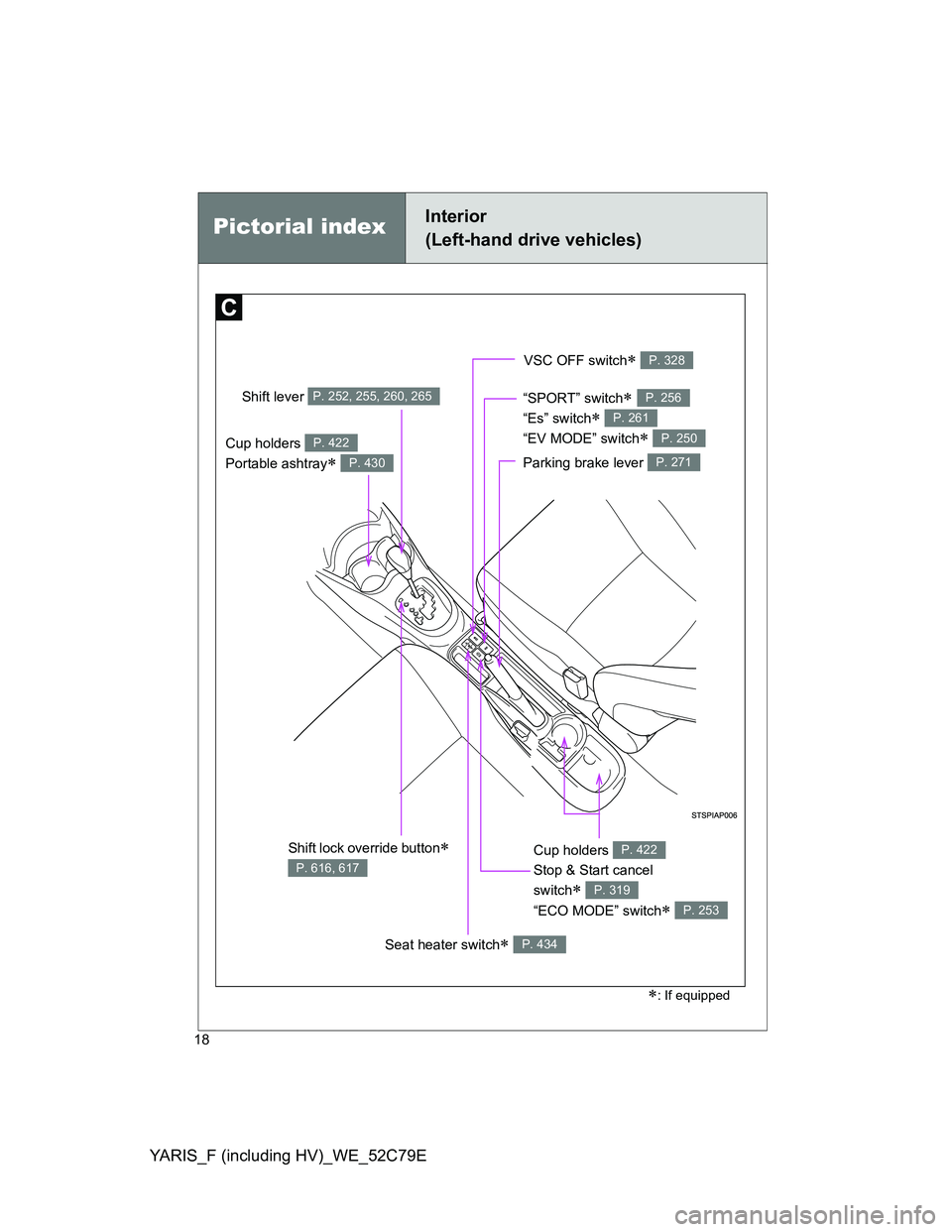
YARIS_F (including HV)_WE_52C79E
18
VSC OFF switch P. 328
“SPORT” switch
“Es” switch
“EV MODE” switch
P. 256
P. 261
P. 250Cup holders
Portable ashtray
P. 422
P. 430
Shift lever P. 252, 255, 260, 265
Parking brake lever P. 271
Cup holders P. 422
Stop & Start cancel
switch
“ECO MODE” switch
P. 319
P. 253
Seat heater switch P. 434
Shift lock override button
P. 616, 617
: If equipped
Pictorial indexInterior
(Left-hand drive vehicles)
Page 30 of 704
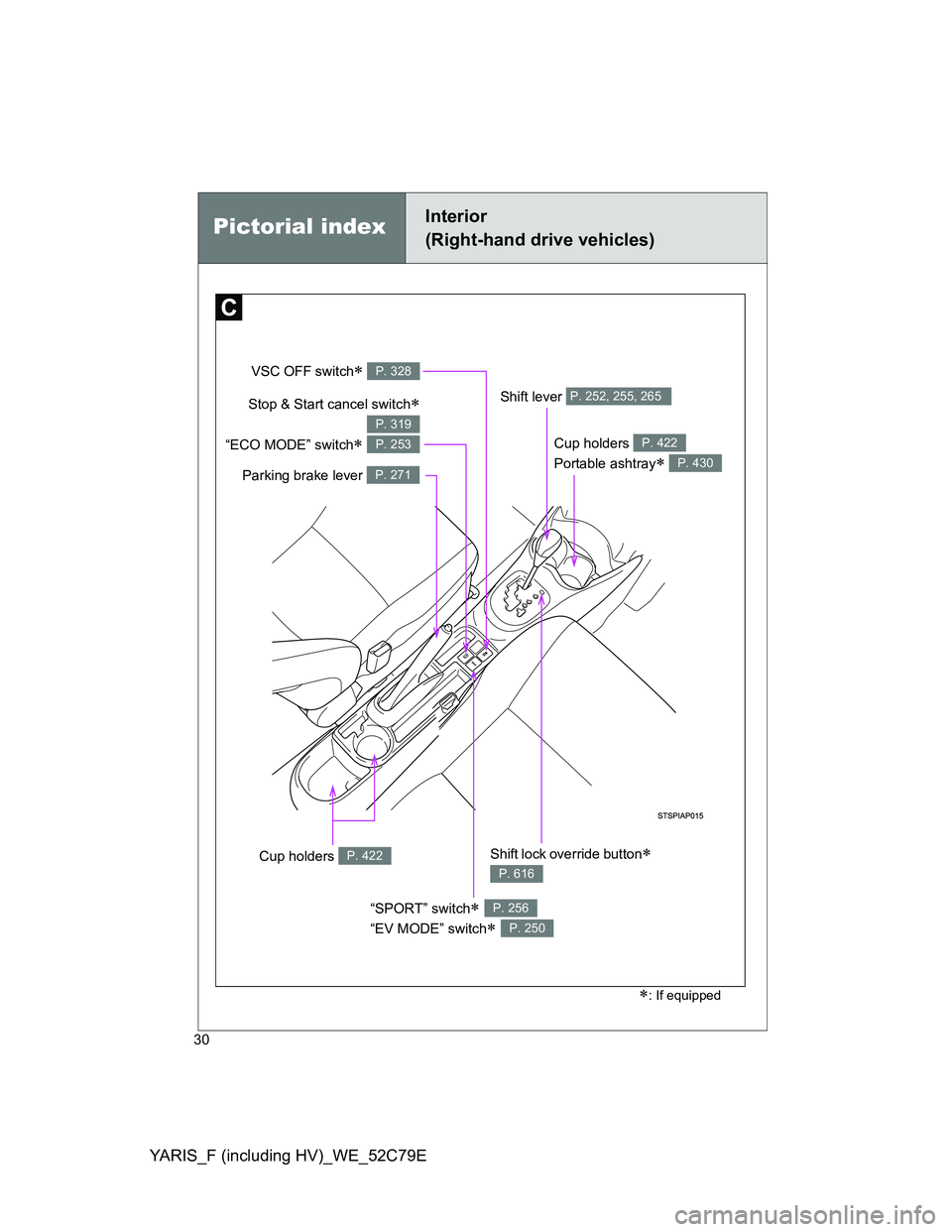
YARIS_F (including HV)_WE_52C79E
30
: If equipped
VSC OFF switch P. 328
Cup holders
Portable ashtray
P. 422
P. 430
Shift lever P. 252, 255, 265
Parking brake lever P. 271
Cup holders P. 422
Stop & Start cancel switch
“ECO MODE” switch
P. 319
P. 253
Shift lock override button
P. 616
“SPORT” switch
“EV MODE” switch
P. 256
P. 250
Pictorial indexInterior
(Right-hand drive vehicles)
Page 39 of 704
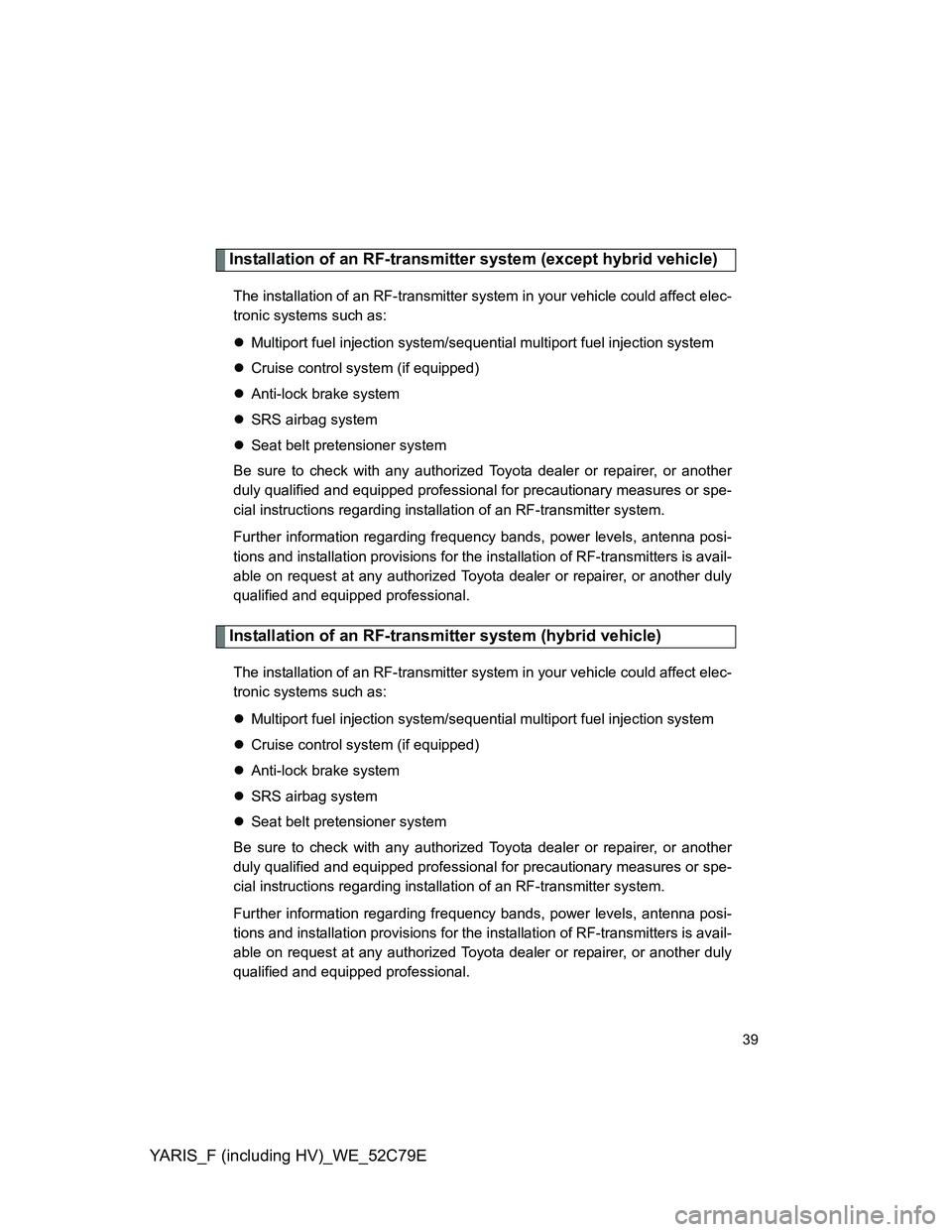
YARIS_F (including HV)_WE_52C79E
39
Installation of an RF-transmitter system (except hybrid vehicle)
The installation of an RF-transmitter system in your vehicle could affect elec-
tronic systems such as:
Multiport fuel injection system/sequential multiport fuel injection system
Cruise control system (if equipped)
Anti-lock brake system
SRS airbag system
Seat belt pretensioner system
Be sure to check with any authorized Toyota dealer or repairer, or another
duly qualified and equipped professional for precautionary measures or spe-
cial instructions regarding installation of an RF-transmitter system.
Further information regarding frequency bands, power levels, antenna posi-
tions and installation provisions for the installation of RF-transmitters is avail-
able on request at any authorized Toyota dealer or repairer, or another duly
qualified and equipped professional.
Installation of an RF-transmitter system (hybrid vehicle)
The installation of an RF-transmitter system in your vehicle could affect elec-
tronic systems such as:
Multiport fuel injection system/sequential multiport fuel injection system
Cruise control system (if equipped)
Anti-lock brake system
SRS airbag system
Seat belt pretensioner system
Be sure to check with any authorized Toyota dealer or repairer, or another
duly qualified and equipped professional for precautionary measures or spe-
cial instructions regarding installation of an RF-transmitter system.
Further information regarding frequency bands, power levels, antenna posi-
tions and installation provisions for the installation of RF-transmitters is avail-
able on request at any authorized Toyota dealer or repairer, or another duly
qualified and equipped professional.
Page 40 of 704
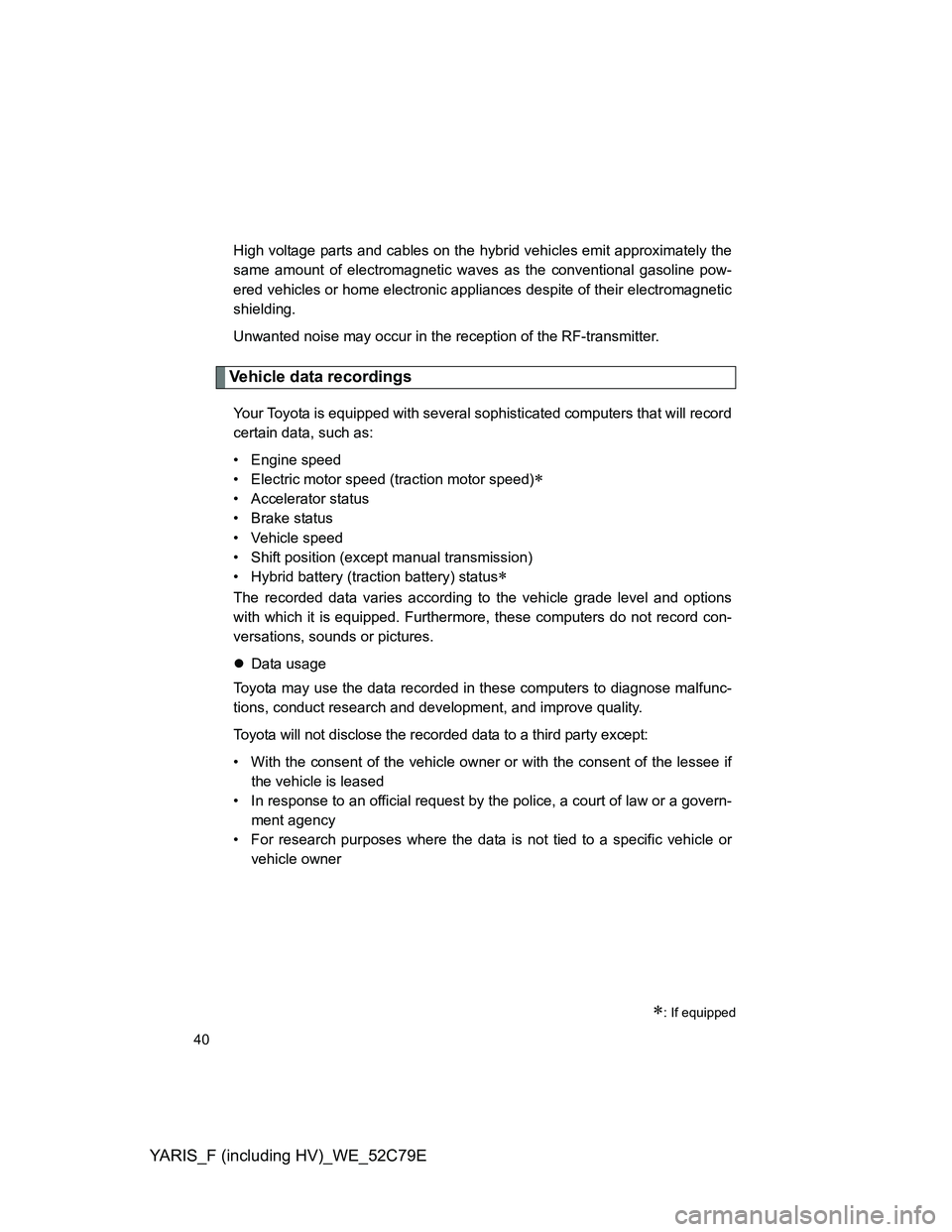
YARIS_F (including HV)_WE_52C79E
40
High voltage parts and cables on the hybrid vehicles emit approximately the
same amount of electromagnetic waves as the conventional gasoline pow-
ered vehicles or home electronic appliances despite of their electromagnetic
shielding.
Unwanted noise may occur in the reception of the RF-transmitter.
Vehicle data recordings
Your Toyota is equipped with several sophisticated computers that will record
certain data, such as:
• Engine speed
• Electric motor speed (traction motor speed)
• Accelerator status
• Brake status
• Vehicle speed
• Shift position (except manual transmission)
• Hybrid battery (traction battery) status
The recorded data varies according to the vehicle grade level and options
with which it is equipped. Furthermore, these computers do not record con-
versations, sounds or pictures.
Data usage
Toyota may use the data recorded in these computers to diagnose malfunc-
tions, conduct research and development, and improve quality.
Toyota will not disclose the recorded data to a third party except:
• With the consent of the vehicle owner or with the consent of the lessee if
the vehicle is leased
• In response to an official request by the police, a court of law or a govern-
ment agency
• For research purposes where the data is not tied to a specific vehicle or
vehicle owner
: If equipped
Page 41 of 704
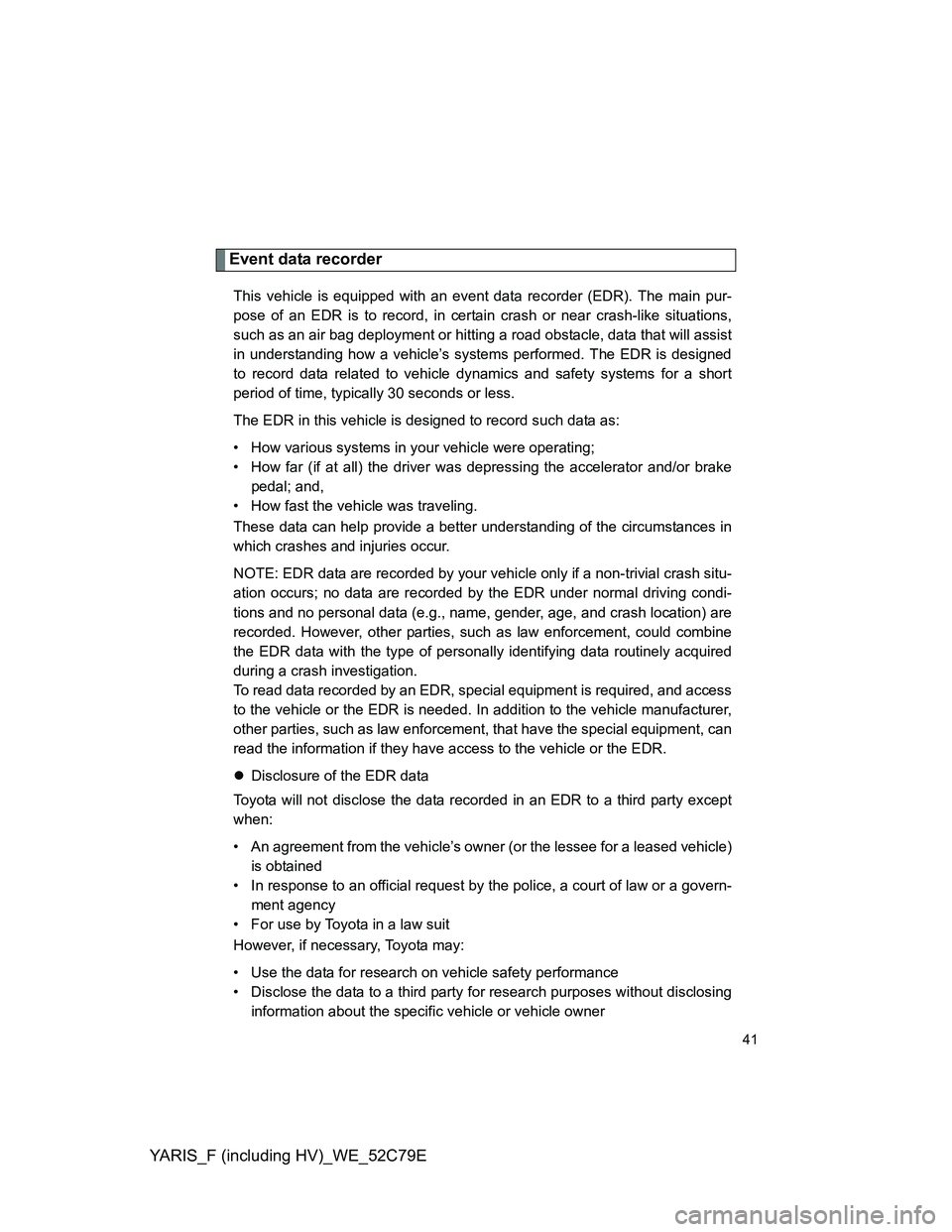
YARIS_F (including HV)_WE_52C79E
41
Event data recorder
This vehicle is equipped with an event data recorder (EDR). The main pur-
pose of an EDR is to record, in certain crash or near crash-like situations,
such as an air bag deployment or hitting a road obstacle, data that will assist
in understanding how a vehicle’s systems performed. The EDR is designed
to record data related to vehicle dynamics and safety systems for a short
period of time, typically 30 seconds or less.
The EDR in this vehicle is designed to record such data as:
• How various systems in your vehicle were operating;
• How far (if at all) the driver was depressing the accelerator and/or brake
pedal; and,
• How fast the vehicle was traveling.
These data can help provide a better understanding of the circumstances in
which crashes and injuries occur.
NOTE: EDR data are recorded by your vehicle only if a non-trivial crash situ-
ation occurs; no data are recorded by the EDR under normal driving condi-
tions and no personal data (e.g., name, gender, age, and crash location) are
recorded. However, other parties, such as law enforcement, could combine
the EDR data with the type of personally identifying data routinely acquired
during a crash investigation.
To read data recorded by an EDR, special equipment is required, and access
to the vehicle or the EDR is needed. In addition to the vehicle manufacturer,
other parties, such as law enforcement, that have the special equipment, can
read the information if they have access to the vehicle or the EDR.
Disclosure of the EDR data
Toyota will not disclose the data recorded in an EDR to a third party except
when:
• An agreement from the vehicle’s owner (or the lessee for a leased vehicle)
is obtained
• In response to an official request by the police, a court of law or a govern-
ment agency
• For use by Toyota in a law suit
However, if necessary, Toyota may:
• Use the data for research on vehicle safety performance
• Disclose the data to a third party for research purposes without disclosing
information about the specific vehicle or vehicle owner
Page 49 of 704
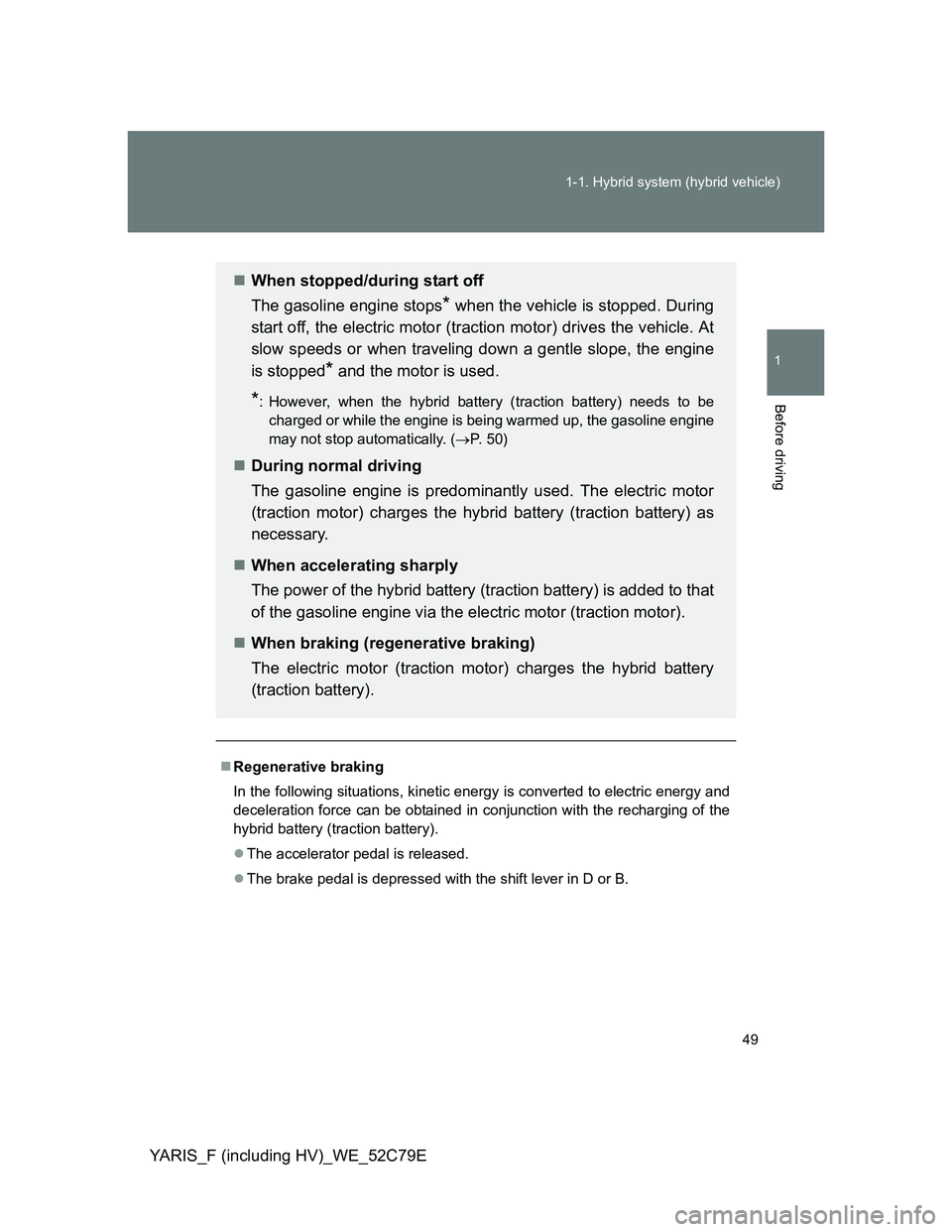
49 1-1. Hybrid system (hybrid vehicle)
1
Before driving
YARIS_F (including HV)_WE_52C79E
Regenerative braking
In the following situations, kinetic energy is converted to electric energy and
deceleration force can be obtained in conjunction with the recharging of the
hybrid battery (traction battery).
The accelerator pedal is released.
The brake pedal is depressed with the shift lever in D or B.
When stopped/during start off
The gasoline engine stops
* when the vehicle is stopped. During
start off, the electric motor (traction motor) drives the vehicle. At
slow speeds or when traveling down a gentle slope, the engine
is stopped
* and the motor is used.
*: However, when the hybrid battery (traction battery) needs to be
charged or while the engine is being warmed up, the gasoline engine
may not stop automatically. (P. 50)
During normal driving
The gasoline engine is predominantly used. The electric motor
(traction motor) charges the hybrid battery (traction battery) as
necessary.
When accelerating sharply
The power of the hybrid battery (traction battery) is added to that
of the gasoline engine via the electric motor (traction motor).
When braking (regenerative braking)
The electric motor (traction motor) charges the hybrid battery
(traction battery).
Page 51 of 704
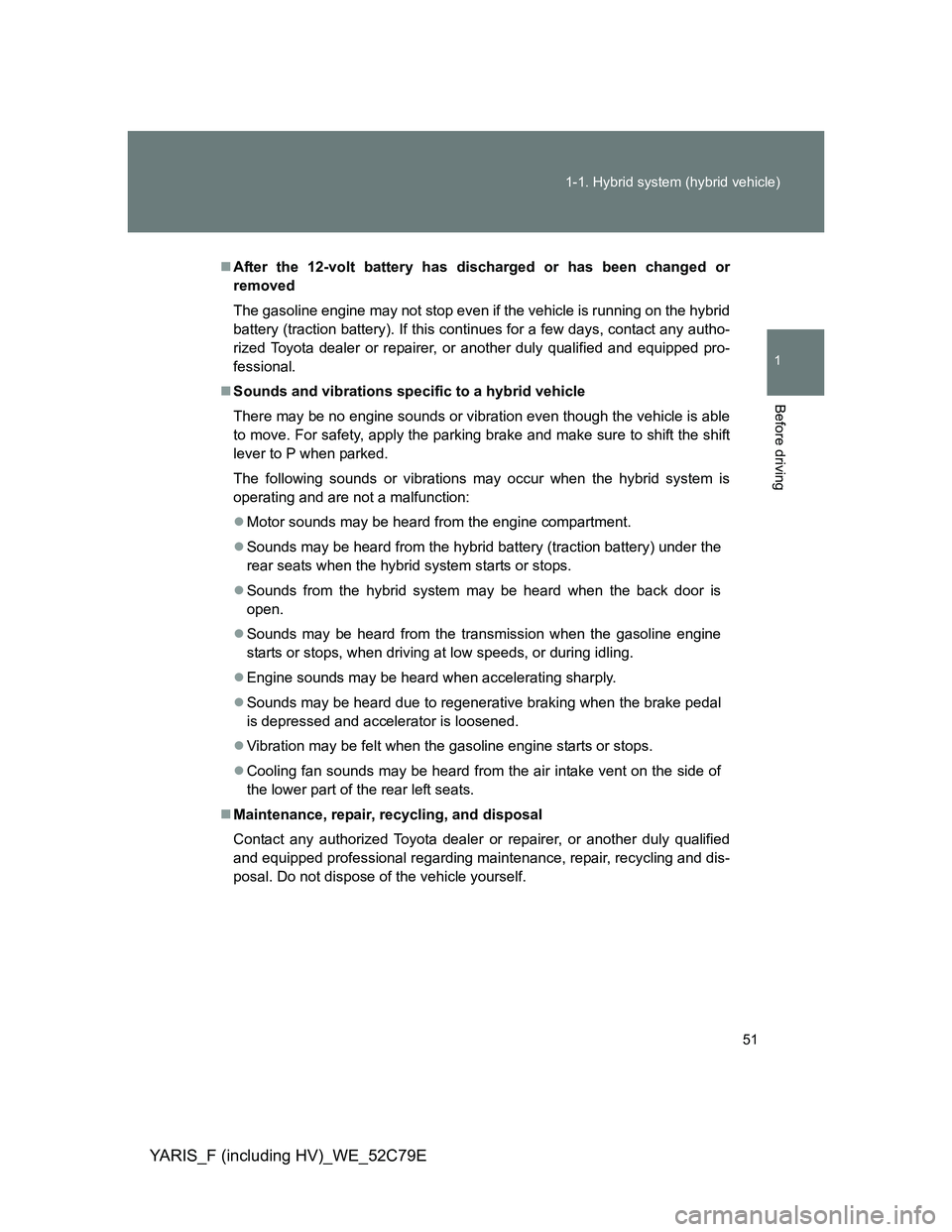
51 1-1. Hybrid system (hybrid vehicle)
1
Before driving
YARIS_F (including HV)_WE_52C79E
After the 12-volt battery has discharged or has been changed or
removed
The gasoline engine may not stop even if the vehicle is running on the hybrid
battery (traction battery). If this continues for a few days, contact any autho-
rized Toyota dealer or repairer, or another duly qualified and equipped pro-
fessional.
Sounds and vibrations specific to a hybrid vehicle
There may be no engine sounds or vibration even though the vehicle is able
to move. For safety, apply the parking brake and make sure to shift the shift
lever to P when parked.
The following sounds or vibrations may occur when the hybrid system is
operating and are not a malfunction:
Motor sounds may be heard from the engine compartment.
Sounds may be heard from the hybrid battery (traction battery) under the
rear seats when the hybrid system starts or stops.
Sounds from the hybrid system may be heard when the back door is
open.
Sounds may be heard from the transmission when the gasoline engine
starts or stops, when driving at low speeds, or during idling.
Engine sounds may be heard when accelerating sharply.
Sounds may be heard due to regenerative braking when the brake pedal
is depressed and accelerator is loosened.
Vibration may be felt when the gasoline engine starts or stops.
Cooling fan sounds may be heard from the air intake vent on the side of
the lower part of the rear left seats.
Maintenance, repair, recycling, and disposal
Contact any authorized Toyota dealer or repairer, or another duly qualified
and equipped professional regarding maintenance, repair, recycling and dis-
posal. Do not dispose of the vehicle yourself.